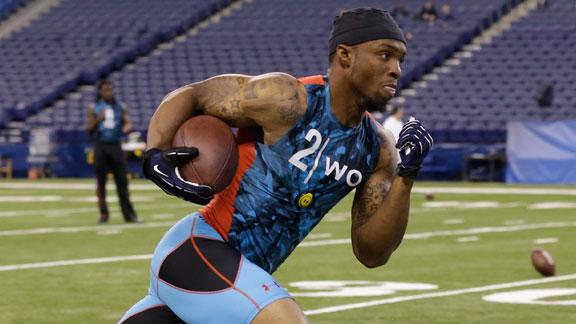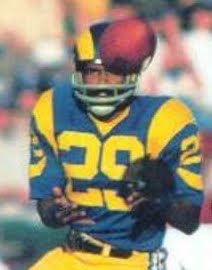- Joined
- Jun 20, 2010
- Messages
- 35,576
- Name
- The Dude

Bernard Miklasz
<a class="postlink" href="http://www.stltoday.com/sports/columns/bernie-miklasz/bernie-bytes-cards-are-road-warriors/article_972c5467-5263-5ecc-8b29-3214b1a2d15f.html" onclick="window.open(this.href);return false;">http://www.stltoday.com/sports/columns/ ... 2d15f.html</a>

Before leaving town on a brief vacation last week, I flipped around to a couple of sports-radio talk shows and was astounded by the number of people that are still making an issue over the height of Rams’ first-round draft choice Tavon Austin. I keep hearing the same thing over and over again: small receivers don’t last in this league. Austin won’t be able to hold up. He’ll get slammed around, and he’ll break.
Austin is 5-9 and weighs around 173 pounds. The Rams believe he’ll play at about 180 early in his career, as he fills out and gains strength.
I’ve started to do some research on this and will share it when I’m done. But this much already is obvious to me: this foolish notion of “small receivers don’t last” is absolutely wrong. There’s no basis in fact for it. It’s an urban legend, put forward by lazy minds.
Smallish receivers haven’t gotten as many opportunities because NFL scouts, GMs and coaches are generally hung up on a player’s measurables, including height. That historical bias is why we haven’t seen as many short receivers. It has nothing to do with their attrition rate. But the offensive game has changed into a more wide-open adventure, with coaches scheming to create mismatches and get playmakers into space to do their thing. Accordingly, more "smallish" receivers are being deployed by open-minded football leadership.
But even before offenses spread out and went with a more up-tempo pace, we saw shorter wide receivers go off repeatedly for long catches, big plays, touchdowns, etc.
The St. Louis football Cardinals were greatly enhanced by the presence of wide receiver Mel Gray, who stood 5-9 and weighed 175 pounds. Over a five-season period from 1973-1977, Gray was tied for fourth among NFL wideouts with 34 touchdown catches, ranked second in the league with an average of 19.4 yards per reception, and ranked fourth with 3,677 receiving yards.
In 1984, when Dan Marino set NFL single-season records for most passing yards (5,084) and TD passes (48), his starting receivers were a pair of 5-9 guys: Mark Clayton and Mark Duper. They combined for 144 catches, 2,695 yards and 26 TDs in ‘84. And Miami’s third wideout that season was the 5-9 Nat Moore, who had 43 catches for 573 yards and 6 TDs.
Ever heard of the Washington Redskins' "Smurfs" wide receivers. Google it. But one of them, Alvin Garrett, stood 5-7.
Via email and Twitter, I’ve had people cite Philadelphia's DeSean Jackson as an example of why it’s risky business to draft a smaller receiver. (Jackson is 5-11, 178 pounds.) Jackson is always banged up, they say. That’s why you have to go with bigger receivers. Jackson is always hurt.
That opinion would be good for one thing: making fertilizer.
Jackson was drafted in 2008; there were 35 wideouts chosen that year. Among the 35 wide receivers taken in 2008 — many of them much bigger than Jackson — this is where Jackson ranks in the key categories:
Games started: 71, first. And the 71 starts are 18 more than the second-highest total from the ’08 WR class.
Receiving yards: 4,785, first. And Jackson has 1,509 more receiving yards than any wideout selected in ’08.
Yards from scrimmage: 5,156, first. In fact only nine NFL wide receivers, total, have more yards from scrimmage than Jackson since 2008.
All-purpose yards: 6,398, first. That includes yards on returns and Jackson is one of the league’s best punt returners.
Touchdowns: 30, first.
Pro Bowls: two, which ranks first from the '08 class of wide receivers.
But Jackson is always banged up, always hurt. He shows why it’s silly to draft smaller receivers.
Yeah, right.
Thanks for reading …
— Bernie
<a class="postlink" href="http://www.stltoday.com/sports/columns/bernie-miklasz/bernie-bytes-cards-are-road-warriors/article_972c5467-5263-5ecc-8b29-3214b1a2d15f.html" onclick="window.open(this.href);return false;">http://www.stltoday.com/sports/columns/ ... 2d15f.html</a>

Before leaving town on a brief vacation last week, I flipped around to a couple of sports-radio talk shows and was astounded by the number of people that are still making an issue over the height of Rams’ first-round draft choice Tavon Austin. I keep hearing the same thing over and over again: small receivers don’t last in this league. Austin won’t be able to hold up. He’ll get slammed around, and he’ll break.
Austin is 5-9 and weighs around 173 pounds. The Rams believe he’ll play at about 180 early in his career, as he fills out and gains strength.
I’ve started to do some research on this and will share it when I’m done. But this much already is obvious to me: this foolish notion of “small receivers don’t last” is absolutely wrong. There’s no basis in fact for it. It’s an urban legend, put forward by lazy minds.
Smallish receivers haven’t gotten as many opportunities because NFL scouts, GMs and coaches are generally hung up on a player’s measurables, including height. That historical bias is why we haven’t seen as many short receivers. It has nothing to do with their attrition rate. But the offensive game has changed into a more wide-open adventure, with coaches scheming to create mismatches and get playmakers into space to do their thing. Accordingly, more "smallish" receivers are being deployed by open-minded football leadership.
But even before offenses spread out and went with a more up-tempo pace, we saw shorter wide receivers go off repeatedly for long catches, big plays, touchdowns, etc.
The St. Louis football Cardinals were greatly enhanced by the presence of wide receiver Mel Gray, who stood 5-9 and weighed 175 pounds. Over a five-season period from 1973-1977, Gray was tied for fourth among NFL wideouts with 34 touchdown catches, ranked second in the league with an average of 19.4 yards per reception, and ranked fourth with 3,677 receiving yards.
In 1984, when Dan Marino set NFL single-season records for most passing yards (5,084) and TD passes (48), his starting receivers were a pair of 5-9 guys: Mark Clayton and Mark Duper. They combined for 144 catches, 2,695 yards and 26 TDs in ‘84. And Miami’s third wideout that season was the 5-9 Nat Moore, who had 43 catches for 573 yards and 6 TDs.
Ever heard of the Washington Redskins' "Smurfs" wide receivers. Google it. But one of them, Alvin Garrett, stood 5-7.
Via email and Twitter, I’ve had people cite Philadelphia's DeSean Jackson as an example of why it’s risky business to draft a smaller receiver. (Jackson is 5-11, 178 pounds.) Jackson is always banged up, they say. That’s why you have to go with bigger receivers. Jackson is always hurt.
That opinion would be good for one thing: making fertilizer.
Jackson was drafted in 2008; there were 35 wideouts chosen that year. Among the 35 wide receivers taken in 2008 — many of them much bigger than Jackson — this is where Jackson ranks in the key categories:
Games started: 71, first. And the 71 starts are 18 more than the second-highest total from the ’08 WR class.
Receiving yards: 4,785, first. And Jackson has 1,509 more receiving yards than any wideout selected in ’08.
Yards from scrimmage: 5,156, first. In fact only nine NFL wide receivers, total, have more yards from scrimmage than Jackson since 2008.
All-purpose yards: 6,398, first. That includes yards on returns and Jackson is one of the league’s best punt returners.
Touchdowns: 30, first.
Pro Bowls: two, which ranks first from the '08 class of wide receivers.
But Jackson is always banged up, always hurt. He shows why it’s silly to draft smaller receivers.
Yeah, right.
Thanks for reading …
— Bernie

